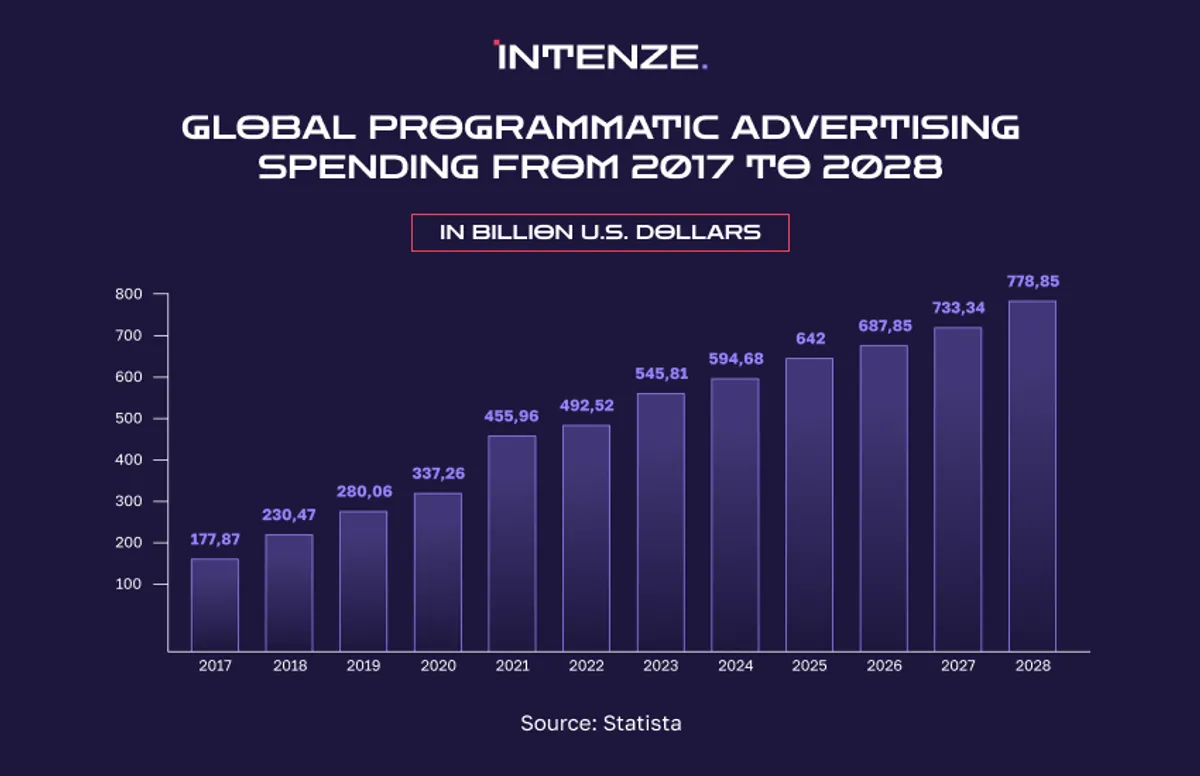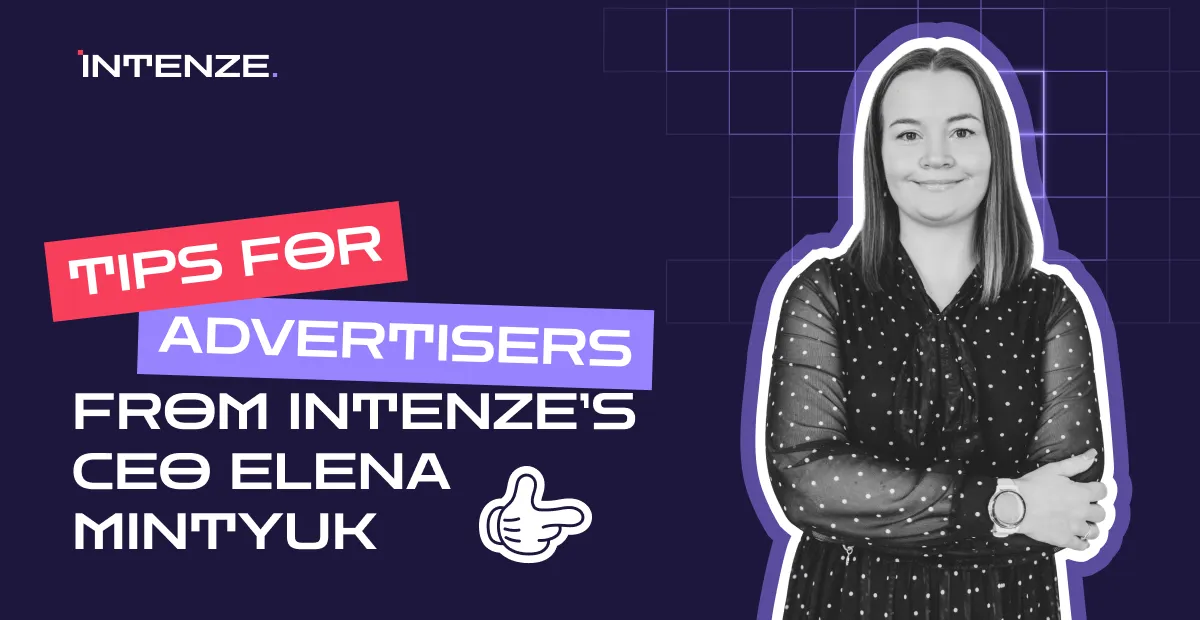Today, staying ahead in programmatic advertising is truly a necessity. The numbers speak for themselves: global programmatic ad spend is expected to reach $687,85 billion by 2026, with over 90% of digital display advertising now being purchased programmatically. These figures highlight the growing dominance of data-driven, automated ad buying, where AI, privacy regulations, and cross-channel strategies play a critical role.

As automation, AI, and privacy regulations reshape the industry, advertisers must embrace new strategies to remain competitive. In this article, Elena Mintyuk, CEO of Intenze, an innovative programmatic advertising company, shares practical tips for advertisers looking to optimize their campaigns, boost engagement, and future-proof their strategies in a cookie-less, AI-powered world. Whether you’re an experienced marketer or just diving into programmatic, these insights will help you navigate the challenges and unlock the full potential of data-driven advertising.
The Current Programmatic Landscape
It is no secret that all advertisers face new challenges today, including privacy regulations, the phase-out of third-party cookies, and an increased demand for transparency. The shift toward a cookieless future, driven by policies like GDPR, CCPA, and Google’s Privacy Sandbox, is pushing brands to adopt first-party data strategies, AI-driven automation, and contextual targeting as essential tools to stay competitive.
At the same time, CTV, video, and banner advertising are undergoing significant transformations. CTV advertising is experiencing exponential growth, with ad spend expected to surpass $33.35 billion in 2025. By 2028, that number is expected to grow to $46.89 billion — surpassing traditional TV advertising for the first time.

Advertisers are embracing programmatic CTV buying, leveraging addressable TV, dynamic ad insertion, and household-level targeting to improve audience engagement. In the video advertising space, trends like shoppable video ads, interactive content, and AI-powered personalization are redefining user experiences, making ads more engaging and performance-driven. Meanwhile, banner advertising remains a core pillar of programmatic, evolving through rich media formats, dynamic creatives, and RTB enhancements to maximize viewability and engagement.
As a result, brands are experimenting with new ad formats, leveraging machine learning for predictive analytics, and integrating omnichannel strategies to ensure maximum impact across devices and platforms. The key to success in today’s programmatic ecosystem lies in adapting to regulatory shifts, embracing AI-driven automation, and investing in innovative ad technologies that align with evolving consumer behaviors.
Key Tips for Advertisers
Tip 1: Let Data Be Your Superpower
Stop guessing – start knowing! Data is your secret weapon, so harness AI, analytics, and first-party insights to make smarter, sharper ad decisions.
To fully harness the power of data, advertisers must move beyond third-party cookies and build robust first-party data strategies. A strong data strategy goes beyond just knowing who your audience is – it’s about understanding when, where, and how to reach them most effectively. The use of predictive analytics can enable advertisers to anticipate what users might be interested in before they even realize it themselves. The brands that successfully implement AI-powered targeting, real-time bid optimization, and automated creative personalization will not only drive higher engagement and conversion rates but will also be better prepared for the cookieless future of digital advertising.
Tip 2: Be Everywhere Your Audience Is
The modern consumer is constantly connected – watching streaming content on a smart TV, scrolling through social media on a smartphone, reading an article on a laptop, and shopping on a tablet, often all within a single day. Advertisers who limit themselves to a single channel risk missing out on valuable touchpoints that could reinforce their brand message and drive conversions. A true multi-channel strategy ensures that your brand remains visible and relevant across the entire consumer journey.
Advertisers who understand how to tailor their messaging for each platform and device – whether it’s a static display ad on a website, an interactive CTV spot, or a native ad embedded in an article – will create a more seamless and immersive brand experience for consumers.
Tip 3: Keep It Real – Transparency Wins
Nobody likes shady ads. Build trust with clear, brand-safe messaging, work with reputable partners, and stay ahead of ad fraud.
Programmatic advertising has long struggled with issues like ad fraud, brand safety concerns, and a lack of visibility into supply chains. Advertisers must take an active role in ensuring that their campaigns run in safe, high-quality environments. This means partnering with trusted programmatic platforms, leveraging ad verification tools, and implementing brand safety controls to avoid placements next to inappropriate or low-quality content.
Moreover, privacy compliance is no longer just a legal necessity – it’s a competitive advantage. Brands that prioritize ethical data collection, offer consumers more control over their preferences, and communicate openly about how they use audience data will build greater trust and long-term loyalty. Transparency isn’t just about where your ads appear – it’s also about how you communicate with your audience, ensuring that your messaging is clear, honest, and aligned with their expectations.
Tip 4: Make Ads That Don’t Feel Like Ads
Static is boring – go dynamic! Personalization and bold, creative storytelling turn ads into experiences. The most effective ads today blend seamlessly into the content people are already engaging with, providing real value instead of disrupting their experience. Advertisers who prioritize creativity and personalization will see higher engagement, stronger brand recall, and more meaningful interactions.
Personalization is no longer just about inserting a user’s first name into an email - it’s about leveraging real-time data and AI to tailor ad experiences at scale. Dynamic creative optimization allows brands to serve different ad variations to different audience segments based on factors like browsing behavior, location, device type, and even mood. By testing multiple creative elements - including imagery, messaging, and CTAs - advertisers can ensure that every impression is highly relevant and impactful.
At the same time, interactive formats - such as shoppable video ads, gamified experiences, and immersive AR activations - offer consumers a more engaging way to connect with brands. Rather than passively consuming content, users can now actively interact with ads, making the experience more memorable and persuasive.
Tip 5: Test, Tweak, and Try Again
I am sure that the most successful advertisers are those who constantly experiment, analyze results, and iterate on their approach. With advancements in AI and automation, brands can now test multiple ad creatives, audience segments, and bidding strategies simultaneously, ensuring that campaigns are optimized in real-time for maximum performance.
A/B testing should be an ongoing process, not just a one-time exercise. Advertisers should experiment with different ad formats, targeting techniques, and messaging variations, using data-driven insights to determine what resonates best with their audience. The rise of automated bidding strategies and AI-powered campaign optimization means that brands can now adjust budgets, placements, and creatives dynamically based on real-time performance metrics.
Final Thoughts
Programmatic advertising is no longer just about buying impressions at scale - it’s about delivering highly relevant, engaging, and privacy-conscious ad experiences. The future belongs to brands that embrace data-driven strategies, leverage AI-powered optimization, and prioritize creativity while maintaining transparency and consumer trust.
Those who adapt, experiment, and innovate will not only survive - but thrive.
